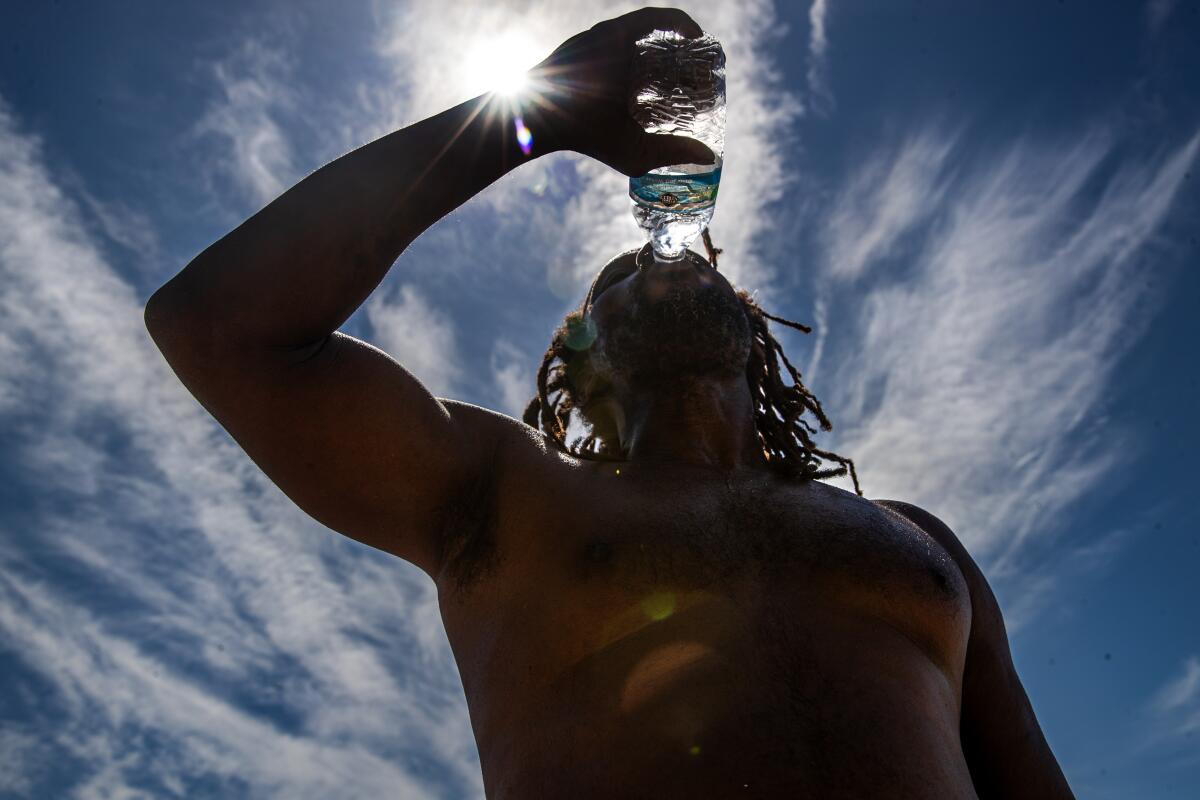Climate change-attributed heat touched 81% of the world’s population in July, study finds

- Share via
Four out of every five humans alive experienced at least one day of abnormally hot temperatures in July — a global onslaught of extreme heat that would not have been possible without climate change, according to new research.
The sweltering month appears to have been the hottest ever recorded on the planet, although official verification from federal meteorological agencies is pending.
But an analysis of daily temperatures in 4,700 cities found that climate change-attributed heat touched 6.5 billion people — or 81% of the world’s population — in July. The report, released Wednesday by the nonprofit news organization Climate Central, measured the impact using the Climate Shift Index, a tool that compares the current climate to one without excess heat-trapping emissions.
Global exposure peaked July 10, when 3.5 billion people experienced a Climate Shift Index level of 3 or higher, indicating that human-caused climate change made unusually hot temperatures at least three times more likely, the report said. At least 2 billion people felt a CSI level 3 or higher on each of the 31 days in July.
“There’s nothing about this that is normal,” said Andrew Pershing, vice president of science at Climate Central, during a press briefing Tuesday. “These are conditions that are going to become more common, more severe, as we continue to put more and more CO2 in the atmosphere. Until there’s no more CO2 being added to the atmosphere, temperatures are going to continue to rise, and this year eventually will start to look like an average year, or a cool year.”
Huge swaths of the U.S., including California, are expected to see warmer-than-average temperatures in August, government forecasters say.
The findings build on a related analysis from World Weather Attribution — a research group that seeks to determine the role of climate change in extreme weather events. It recently found that the intense heat waves that simultaneously baked the southwestern U.S., Europe and China in July would not have been possible without climate change.
Global warming due to the burning of fossil fuels made the European heat wave 4.5 degrees hotter, the one in the United States and Mexico 3.6 degrees hotter and the one in China 1.8 degrees hotter, that study found.
While the National Oceanic and Atmospheric Administration and other agencies have not yet verified that July was the hottest month ever recorded, daily data make it “pretty clear that we’re going to set that record,” Pershing said. From July 3 through 31, global daily average temperatures were continuously hotter than the previous record set in August 2016.
That 81% of the planet’s population experienced such abnormal temperatures is “unfortunately not a major surprise,” said David Neelin, a distinguished professor of atmospheric and oceanic sciences at UCLA who was not involved in the Climate Central study.
“There’s a lot of population in the tropical latitudes,” Neelin said. “And when you’re ranking the amplification factor of how much you’ve increased your probability due to climate change by population, you find out a lot of the world has experienced extremes they were very unlikely to have experienced without climate change.”
Indeed, though the planet simmered, the worst of the heat was not evenly distributed. In addition to the tropics, regional hot spots included parts of north and central Africa, the Mediterranean basin, south and southeast Asia and the southern United States, according to the report. Those areas saw especially high CSI levels of 4 and 5 — indicating that hot conditions were made at least four or five times more likely due to climate change.
Perhaps nowhere in the U.S. was that heat more relentless than Phoenix, which recorded its hottest month ever with 31 consecutive days of 110 degrees or higher, according to the National Weather Service. Climatologists at Arizona State University said it was the hottest month on record for any U.S. city.
Miami too saw its warmest month on record, with a mean average temperature of 86.5 degrees, according to the NWS.
In California, Death Valley soared to 128 degrees on July 16, “close to the hottest temperature ever recorded on Earth,” the report said. Fresno saw 20 days at a CSI level of 3 or higher, with an average temperature anomaly of 2.5 degrees.
Los Angeles fared much better, with an average temperature anomaly of just 0.8 degrees, and no days with a CSI level of 3 or higher, the report said.
That was largely because the ridge of high pressure that drove the southwestern heat wave was positioned to the east of L.A., according to Robbie Munroe, a meteorologist with the weather service in Oxnard.
“What that does for us is keep at least some marine layer influence — that natural air conditioning of cooler air coming off the Pacific,” he said.
Unusually strong heat waves are becoming more common due to the buildup of greenhouse gases in the atmosphere, researchers say.
Still, the simmering heat brought significant danger to much of the country, according to John Balbus, acting director of the Office of Climate Change and Health Equity with the federal Department of Health and Human Services.
“Heat waves are not new,” Balbus told reporters in a separate briefing Tuesday. “We’ve had heat waves happening in different parts of the country at different times forever, but the size of the heat wave, the duration of the heat wave, and the fact that the heat wave across the United States is being matched by severe and equally unprecedented heat across the Mediterranean — these are all signs of a planetary heat wave.”
Balbus noted that heat kills more people every year than all other kinds of extreme weather. The estimated average of 700 heat deaths per year in the U.S. is “certainly an undercount,” he said, because heat can exacerbate other health issues such as heart and lung problems that won’t get coded as heat on a death certificate. Actual numbers could be as much as tenfold higher.
Additionally, many more people are affected by heat than those who die from it. During heat waves, emergency rooms see a surge of people suffering from heat stress or other issues that require medical care.
In July, the rate of emergency room visits related to heat in the Southwest skyrocketed to about 1,000 people per 100,000 — far more than the average of 20 to 50 people per 100,000, Balbus said.
The week of July 16 was the worst for the region, which saw the rate of heat-related illness soar to 1,248 people per 100,000, according to the Heat & Health Tracker from the U.S. Centers for Disease Control and Prevention.
Balbus noted that high nighttime temperatures are particularly dangerous because they don’t allow people time to cool down. Phoenix saw 19 days in July where low temperatures stayed above 90 degrees, breaking the previous record of 16 such days set in 2020.
“We have to acknowledge that we’re seeing manifestations of climate change, and the kind of heat we’re seeing is likely to get more intense before it gets better,” Balbus said. “Especially if we don’t take strong action to reduce the severity of climate change.”
Neelin, of UCLA, said there may be other factors contributing to the heat, including the recent arrival of El Niño. The climate pattern in the tropical Pacific is a major driver of weather across the world and is associated with warmer global temperatures.
But while El Niño is making global temperatures higher, the current degree of warming would not be possible without climate change pushing normals to new extremes.
“Remember, you’re taking your normal weather patterns and you’re adding them on top of widespread warming due to climate change,” Neelin said. “The thing that normally would have been warmer is now ‘extra-warmer’ thanks to climate change.”









